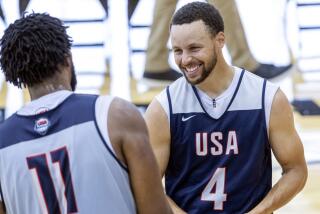Monkeying Around With a Ball
- Share via
I spent my grad school years in a windowless lab moving teensy amounts of fluid between teensy plastic test tubes and growing up big vats of yeast in smelly incubators.
What, I used to wonder, would it have been like to study big biology? Lions! Tigers! Bears! Monkeys! Life forms visible without the aid of a microscope!
Of course, scientists learn all kinds of important biological things from yeast. Like, “Sequences within the spacer region of yeast rRNA cistrons that stimulate 35S rRNA synthesis in vivo mediate RNA polymerase I-dependent promoter and terminator activities.”
But you have to admit there’s something more immediately grabby about a study called “A Comparative Study of Aimed Throwing by Monkeys and Humans.”
We stumbled on this study just by chance the other day and felt compelled to learn more. Who won the throwing contest? The monkeys or the humans?
Lead author Greg Westergaard, of LABS of Virginia, kinda ducked that one--but since the humans were chucking tennis balls and the monkeys were throwing rocks into tubs of peanut butter (and were then given the rocks to lick) the two probably couldn’t be compared. Kind of like grass courts or hard courts.
Westergaard did tell us that in his study (published in the journal Neuropsychologia), the monkeys threw overarm more often and were more apt to throw rocks while standing on three limbs, a finding that “did not surprise” him.
Still, he was more intrigued by the hands the monkeys used to throw their rocks. Humans, he says, are much more likely to be right-handed: “Righties” outnumber “lefties” 9-1. That’s not the case in other primates. In his study, for instance, the monkeys were split pretty much 50-50.
Why this difference? There are theories, he says--that by evolving to favor one hand, our species freed up some of our gray matter to use for other neuron-greedy tasks, like speaking a language.
There are theories, too, about why we evolved the ability to do something as tricky yet seemingly useless as accurately lobbing a ball about. (Just think of all the unconscious calculations the task entails!)
Maybe throwing ability has no use: Maybe it just showed up as a side product of other changes that occurred in our brains. Maybe, though, the ability to throw gave us a survival edge.
“Back in human evolution, if you wanted to hunt a large animal, it would be a much safer bet if you didn’t have to go attack it with your hands but could throw large stones at it and disable it,” Westergaard says. “You were likely to be very successful if you could develop that as a skill.”
This sounds reasonable enough, though it doesn’t explain why I am here, nor any of the rest of my siblings.
*
Throwing a ball is one thing. Catching it is another, quite mind-bogglingly impressive achievement.
Did you know that the human forearm turns upward to catch a falling ball a mere 200 milliseconds before the ball would hit the hand? Wow. Neither did I. Surely my arm’s not that nimble.
But maybe it would be in space, if ball-catching experiments on a 17-day space shuttle mission are anything to go by. Maybe, in space, I’d even have an edge.
In the study, reported in this month’s Nature Neuroscience, astronauts up in the shuttle (between servings of freeze-dried ice cream) repeatedly caught a 400-gram ball projected down at them at various speeds. Muscle sensors measured the precise time at which their arms started moving to catch the ball.
The astronauts did the same ball-catching trick on Earth--and then the Earth and space results were compared.
Guess what? In space, the astronauts all started reaching for the balls too soon--most likely because of the lack of gravity. On Earth, the balls would have started accelerating. In space they didn’t. Yet the astronauts’ brains were still busy grinding out some “grab-it- now “ calculation--one that took Newtonian physics into account.
Newtonian physics, eh. Never my best subject. Maybe that’s why I’m no good at catching balls.
*
If you have an idea for a Booster Shots topic, write or e-mail Rosie Mestel at the Los Angeles Times, 202 W. 1st St., Los Angeles, CA 90012, rosie.mestel@latimes.com.




